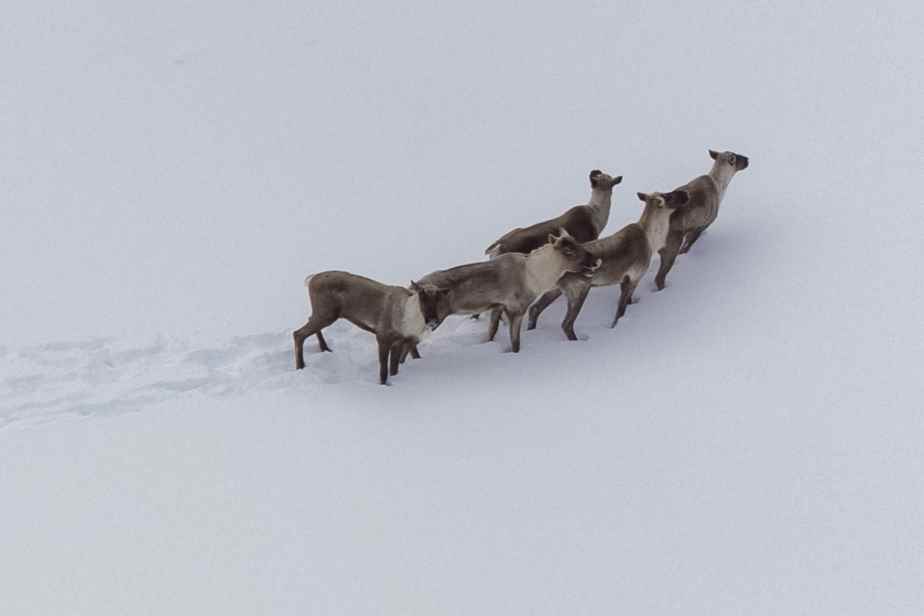(Montreal) Caribou populations in Quebec, heavily disturbed by human activity, continue to decline according to new inventories to be published Monday by the Ministry of the Environment, the Fight against Climate Change, Wildlife and Parks.
The Canadian Press consulted caribou population inventories carried out in 2021 and 2022 in the Gaspésie, Nord-du-Québec and Côte-Nord regions, and in all three regions, populations continue to decline, mainly in due to the destruction of their habitat. Only the Caniapiscau caribou population would be growing.
The ministry carried out these inventories using planes, helicopters, cameras deployed on the territory and in some cases, thanks to telemetric monitoring, therefore using GPS-type collars.
Caribou “Bustard” and “Caniapiscau”
The “Outardes” populations refer to several herds of woodland caribou that live in the Côte-Nord and Saguenay–Lac-Saint-Jean regions and the department estimates that their total number would be between 803 and 1180, “distributed within of 67 groups of 1 to 85 individuals”.
This number is “in decline” and “below the thresholds estimated to hope for the self-sufficiency of the population”.
How are these populations decreasing? It is difficult to determine this according to the director general of the coordination of wildlife management at the Ministry of the Environment.
“This is the first inventory where we did exactly this magnitude and this area, so before that, we did not have such precise sampling, so it is difficult to have robust comparisons”, explained Carl Patenaude-Levasseur at The Canadian Press.
The ministry, however, hypothesizes an “average decrease of 11% of the population per year”.
According to inventory documents, the main disturbances to the habitat of this caribou population are logging roads, logging and burning (clearing by fire).
In these areas, the logging industry has removed much of the old forest and replaced it with younger trees, depriving the caribou of habitat and food. Also, forest roads promote the movement of caribou’s natural predators such as bears and wolves.
According to the Ministry of the Environment, “the low abundance south of 51e parallel poses a risk of local extinction of the groups of caribou found in the south of the range of the species on the North Shore”.
The only good news is that, further north in the territory, 329 caribou from the Caniapiscau population have been listed, but those in charge of the inventories estimate that its real size could be 484 individuals.
The area surveyed at the end of winter 2022 represented only 8.2% of the range of this population, but the data are sufficient for the ministry to estimate that this population, which partly lives in protected areas , is “growing”.
The Nottaway Herd
In the Nord-du-Québec region, the data from the aerial surveys carried out by the teams of the ministry make it possible to evaluate the population of woodland caribou in the Nottaway herd at 282 individuals, compared to 308 in 2016.
The population decline could therefore be 8% in six years. But scientific models that use satellite telemetry provide much more pessimistic estimates.
This leads the Ministry to say that “the exact extent of this decline is difficult to establish with certainty” and “it is possible to estimate that the abundance of the population could have decreased by an order of magnitude of 8% at 28% over the past six years. »
The Nottoway caribou study area extends into the traditional territory of the James Bay Crees: from around Matagami in the south, to near the Rupert River in the north, and the Harricana River in west to Evans, Soscumica and Matagami lakes in the east.
A total of 39 groups of caribou were located during the inventory and the size of the groups varied from 1 to 21 individuals.
The ministry estimates that the survival rate is 81% for females and 71% for males, which “remains relatively low for both segments of the adult population and special attention will therefore have to be paid to this over the next few years. years in order to identify a possible problem”.
Gaspésie mountain caribou
Gaspésie’s mountain caribou live in the Chic-Chocs and McGerrigle mountains. This population was designated as a threatened species in 2009 in Quebec.
“It’s an extremely precarious isolated population,” said Carl Patenaude-Levasseur.
“We saw 33 in 2021, compared to 42 the year before” with “the same methods, which indicates a certain rate of decline”.
The fall 2021 inventory, carried out through an aerial flight and the deployment of 74 cameras, was carried out in three sectors: Mounts Albert, McGerrigle and Logan.
“The high mortality rate of calves from predation, the relatively high adult mortality rate, the small population size, the lack of interchange within the population due to territorial fragmentation, and the lack of preferential non-fragmented habitats, jeopardize the maintenance of this population”, can we read in the documents of the inventories of the ministry.
The researchers also point out that a recent study shows that the surface area of black bear and coyote habitats, caribou predators, “has increased within a radius of 30 km around the legal habitat of Gaspésie caribou in over the past 30 years”. It is also indicated that “the transformation of the forest landscape could have contributed to the exacerbation of the predation pressure on the caribou, particularly on the calves”.
The Quebec woodland caribou recovery team estimated that between 5,635 and 9,981 caribou remained on the territory in the period from 2005 to 2016.
But these estimates no longer correspond to reality and the inventories that are underway in several regions of Quebec will provide a clearer picture of the extent of the decline of this emblematic animal.
The Ministry of the Environment, the Fight against Climate Change, Wildlife and Parks plans “the delivery of the strategy for forest-dwelling and mountain caribou” in the summer of 2023.
